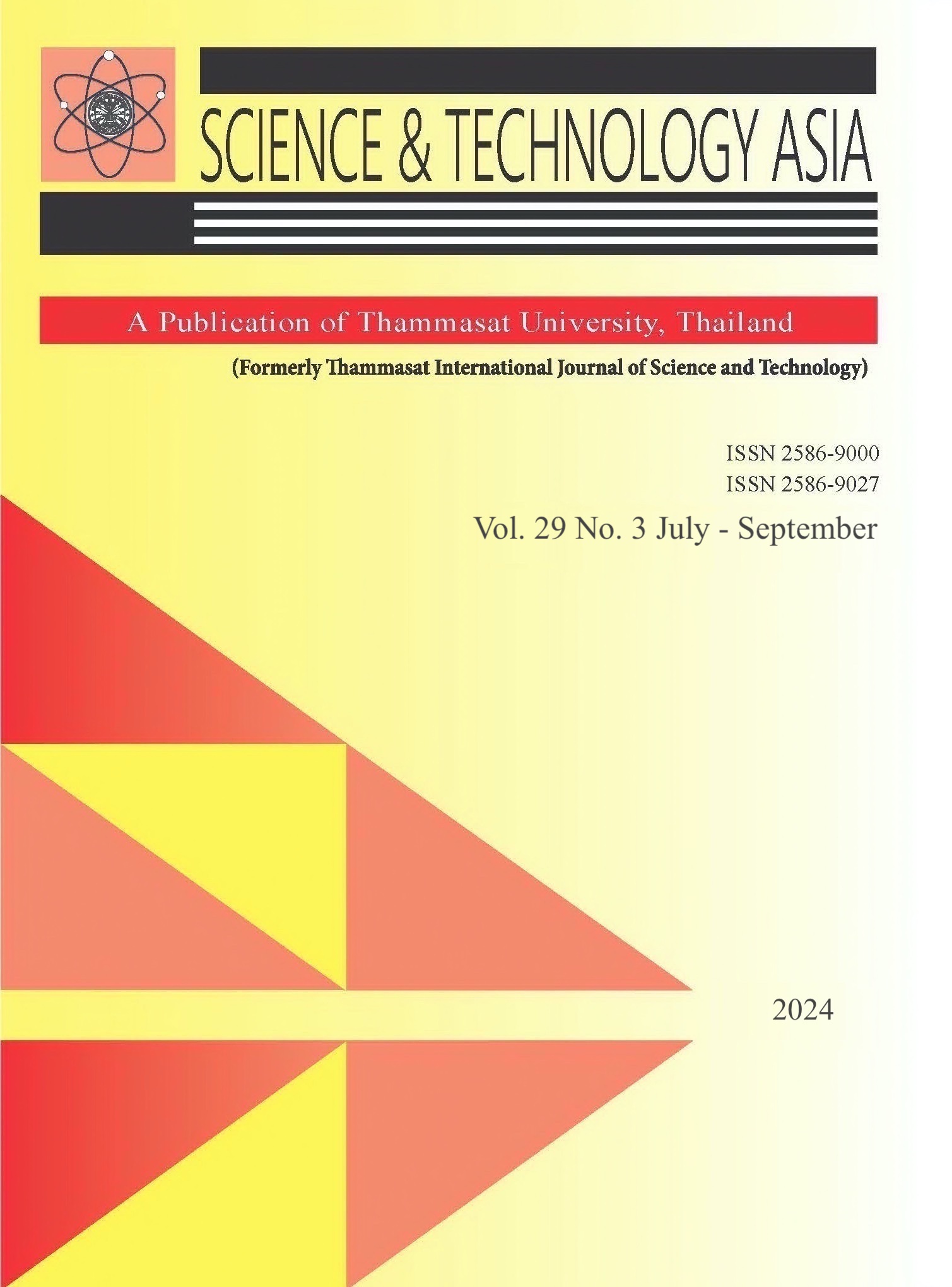In Silico Identification of Bajakah Root (Spatholobus littoralis Hassk) Alkaloid Compounds to Stimulate Lipolysis Through Inhibition of Phosphodiesterase-4
Main Article Content
Abstract
Modulating the nucleotide cycle signaling of phosphodiesterases (PDEs) can facilitate thermogenesis. When it comes to obesity therapy, utilizing herbs as part of non-pharmacological treatment methods is highly recommended due to the lower risks involved compared to pharmacological methods. Bajakah root, a typical plant found in West Kalimantan, also known by its Latin name, Spatholobus littoralis Hassk (S. littoralis Hassk), is currently being extensively researched. Isorhynchophylline and rhynchophylline are common alkaloids found in S. littoralis Hassk. The objective of this study was to explore the potential of these two alkaloids through an in silico approach. Chem3D Pro software was used to prepare ligands with energy conformations for accurate docking results via AutoDock Vina software. The visualization was carried out in Biovia Discovery Studio. The lowest binding energy values were obtained for the PDE4C isoform, with values of -9.14, -7.61, and -5.61 kcal/mol, respectively. The interaction between isorhynchophylline and PDE4C had the lowest binding energy. In silico studies suggest that two alkaloid components, isorhynchophylline and rhynchophylline, found in S. littoralis Hassk have the potential to increase lipolysis activity.
Article Details

This work is licensed under a Creative Commons Attribution-NonCommercial-NoDerivatives 4.0 International License.
References
Fruh SM. Obesity: Risk factors, complications, and strategies for sustainable long-term weight management. J Am Assoc Nurse Pract. 2017;29:S3-14.
Hruby A, Hu FB. The Epidemiology of Obesity: A Big Picture. Pharmacoeconomics. 2015 Jul;33(7):673-89.
Lin X, Li H. Obesity: Epidemiology, Pathophysiology, and Therapeutics. Front Endocrinol (Lausanne). 2021;12:706978.
WHO. Obesity and overweight. Available from: https://www.who.int/news-room/-fact-sheets/detail/obesity-and-overweight.
Ruban A, Stoenchev K, Ashrafian H, Teare J. Current treatments for obesity. Clin Med. 2019 May;19(3):205-12.
Wolfe BM, Kvach E, Eckel RH. Treatment of Obesity: Weight Loss and Bariatric Surgery. Circ Res. 2016;118(11):1844-55.
Lenharo M. Anti-obesity drugs’ side effects: what we know so far 2023. Available from: https://www.nature.com-/articles/d41586-023-03183-3.
Gao X, Hua X, Wang X, Xu W, Zhang Y, Shi C, et al. Efficacy and safety of semaglutide on weight loss in obese or overweight patients without diabetes: A systematic review and meta-analysis of randomized controlled trials. Front Pharmacol. 2022;13(September):1-14.
Heise T, DeVries JH, Urva S, Li J, Pratt EJ, Thomas MK, et al. Tirzepatide Reduces Appetite, Energy Intake, and Fat Mass in People With Type 2 Diabetes. Diabetes Care. 2023 May;46(5):998-1004.
Kim JY. Optimal Diet Strategies for Weight Loss and Weight Loss Maintenance. J Obes Metab Syndr. 2021 Mar;30(1):20-31.
Cox CE. Role of Physical Activity for Weight Loss and Weight Maintenance. Diabetes Spectr. 2017 Aug;30(3):157-60.
Taghavi SA, van Wely M, Jahanfar S, Bazarganipour F. Pharmacological and non‐pharmacological strategies for obese women with subfertility. Vol. 2017, The Cochrane Database of Systematic Reviews. 2017.
Haman F, Blondin DP. Shivering thermogenesis in humans: Origin, contribution and metabolic requirement. Temp (Austin, Tex). 2017;4(3):217-26.
Zhang Z, Yang D, Xiang J, Zhou J, Cao H, Che Q, et al. Non-shivering thermogenesis signalling regulation and potential therapeutic applications of brown adipose tissue. Int J Biol Sci. 2021;17(11):2853-70.
Kraynik SM, Miyaoka RS, Beavo JA. PDE3 and PDE4 isozyme-selective inhibitors are both required for synergistic activation of brown adipose tissue. Mol Pharmacol. 2013 Jun;83(6):1155-65.
Jang MH, Mukherjee S, Choi MJ, Kang NH, Pham HG, Yun JW. Theobromine alleviates diet-induced obesity in mice via phosphodiesterase-4 inhibition. Eur J Nutr. 2020;59(8):3503–16. Available from: https://doi.org/10.1007/s00394-020-02184-6.
Coon TA, McKelvey AC, Weathington NM, Birru RL, Lear T, Leikauf GD, et al. Novel PDE4 inhibitors derived from Chinese medicine forsythia. PLoS One. 2014;9(12):e115937.
Ridho FM. Mechanism of Alkaloids and Flavonoids in Bajakah (Uncaria nervosa Elmer) as Antidiabetic Agents. 2023;3(1):9-16.
Tian Z, Zhang S, Wang H, Chen Z, Sun M, Sun L, et al. Intervention of Uncaria and Its Components on Liver Lipid Metabolism in Spontaneously Hypertensive Rats. Front Pharmacol. 2020;11:910.
Purnawati S, Wrasiati LP, Bagus C, Lesmana J, Megantara S, Lesmana R. A study of molecular docking of l-tryptophan ligand as a compound in pineapples and bananas binding with the human serotonin transporter ( SERT ). 2022;11(3):1243-9.
Abidin KR, Lesmana R, Syamsunarno MRAA, Dharma KK. Potential Role of Mitragynine as Lipolysis Stimulator via Adrenergic Signalling: Docking Model Study. Pharmacogn J. 2022;14(5).
Wiltgen M. Algorithms for structure comparison and analysis: Homology modelling of proteins. Vols. 1-3, Encyclopedia of Bioinformatics and Computational Biology: ABC of Bioinformatics. Elsevier Ltd.; 2018. 38-61.
Kumar S, Id PAD. Structural and thermodynamic analysis of factors governing the stability and thermal folding/unfolding of SazCA. 2021;(1):1-20.
Nikolaev DM, Shtyrov AA, Panov MS, Jamal A, Chakchir OB, Kochemirovsky VA, et al. A Comparative Study of Modern Homology Modeling Algorithms for Rhodopsin Structure Prediction. ACS omega. 2018 Jul;3(7):7555-66.
Castro-Alvarez A, Costa AM, Vilarrasa J. The Performance of Several Docking Programs at Reproducing Protein- Macrolide-Like Crystal Structures. Molecules. 2017 Jan;22(1).
Kannabiran SA, Gosejacob D, Niemann B, Nikolaev VO, Pfeifer A. Real-time monitoring of cAMP in brown adipocytes reveals differential compartmentation of β(1) and β(3)-adrenoceptor signalling. Mol Metab. 2020 Jul;37:100986.
Mbaye MN, Hou Q, Basu S, Teheux F, Pucci F, Rooman M. A comprehensive computational study of amino acid interactions in membrane proteins. Sci Rep. 2019 Aug;9(1):12043.
Yokota A, Tsumoto K, Shiroishi M, Nakanishi T, Kondo H, Kumagai I. Contribution of asparagine residues to the stabilization of a proteinaceous antigenantibody complex, HyHEL-10-hen egg white lysozyme. J Biol Chem. 2010 Mar;285(10):7686-96.
Mahata S, Behera SK, Kumar S, Sahoo PK, Sarkar S, Fazil MHUT, et al. In-silico and in-vitro investigation of STAT3-PIM1 heterodimeric complex: Its mechanism and inhibition by curcumin for cancer therapeutics. Int J Biol Macromol. 2022 May;208:356-66.
Prasad S, Cantwell AM, Bush LA, Shih P, Xu H, Di Cera E. Residue Asp-189 controls both substrate binding and the monovalent cation specificity of thrombin. J Biol Chem. 2004 Mar;279(11):10103-8.
Schwabe U, Berndt S, Ebert R. Activation and inhibition of lipolysis in isolated fat cells by various inhibitors of cyclic AMP phosphodiesterase. Naunyn Schmiedebergs Arch Pharmacol. 1972;273(1):62-74.
Zhang R, Maratos-Flier E, Flier JS. Reduced adiposity and high-fat dietinduced adipose inflammation in mice deficient for phosphodiesterase 4B. Endocrinology. 2009 Jul;150(7):3076-82.


